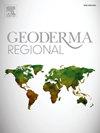通过土壤化学和物理分析表征巴西牧场土壤肥力
IF 3.3
2区 农林科学
Q2 SOIL SCIENCE
引用次数: 0
摘要
巴西主要是各种条件下的牧场,对土壤肥力的系统评估和改进管理战略的需求日益增加。土壤分析是评估肥力的宝贵工具,但它的用途可以扩大,以促进农民、服务提供者和肥料供应商之间更广泛的信息交流。因此,我们的目标是通过土壤化学和物理特性来描述巴西牧场的肥力动态。我们利用从不同土地利用(牧场、综合系统和原生植被)、土壤深度(0-5厘米、5-10厘米、10-20厘米和20-30厘米)和巴西土壤分类系统中提取的质地分类收集的土壤分析结果,基于代表土壤肥力和酸度的两个核心维度确定土地利用肥力剖面,分别解决了总方差的35%和24%。分层比较表明,酸度维度区分了原生植被与综合系统土壤;表层质地组之间的肥力差异在牧场样品中比在综合系统样品中更频繁,并且在深度上减小。砂质土和中等质地土与粘性土和重粘性土的酸度维度存在差异。交叉比较结果表明,放牧条件下沙质土壤的异质性主要集中在20 ~ 30 cm土层。因此,应该在这些深度进行抽样方案,以提高管理战略的效率。该方法旨在通过提高土壤肥力效率,为农业综合企业数字化转型的数据建模范围和可持续粮食供应的全球议程做出贡献。本文章由计算机程序翻译,如有差异,请以英文原文为准。
Soil fertility characterization in Brazilian pastures through soil chemical and physical analysis
Brazil is largely occupied by pastures under varying conditions, rising needs for systematic assessment of soil fertility and improvement of management strategies. Soil analyses are valuable tools for fertility assessment, but its use can be amplified to foster information exchanges between farmers, service providers and fertilizer vendors in broader scales. So, our objective was to characterize the fertility dynamic of Brazilian pastures through its soil chemical and physical properties. We employed soil analysis results collected from different land uses (pasture, integrated system, and native vegetation), soil depths (0–5 cm, 5–10 cm, 10–20 cm, and 20–30 cm) and textural classes extracted from the Brazilian Soil Classification System to determine Land Use Fertility Profiles based on two core dimensions representing soil fertility and acidity, addressing 35 % and 24 % of the total variance, respectively. Stratified comparisons showed that the acidity dimension distinguished native vegetation from integrated system soils; fertility differences between textural groups in superficial layers were more frequent among pastures samples than among integrated systems ones and diminished in depth. The acidity dimension remained differing sandy and medium texture soils from clayey and heavy clayey ones. In the crossed comparisons, our results indicated that sandy soils under pasture concentrate their heterogeneity in deeper layers (20–30 cm). Thus, sampling schemes should be conducted up to these depths to improve efficiency in management strategies. This approach aimed at contributing to the data-modeling scope of agribusiness digital transformation and to the global agenda for sustainable food supply by enhancing soil fertility efficiency.
求助全文
通过发布文献求助,成功后即可免费获取论文全文。
去求助
来源期刊

Geoderma Regional
Agricultural and Biological Sciences-Soil Science
CiteScore
6.10
自引率
7.30%
发文量
122
审稿时长
76 days
期刊介绍:
Global issues require studies and solutions on national and regional levels. Geoderma Regional focuses on studies that increase understanding and advance our scientific knowledge of soils in all regions of the world. The journal embraces every aspect of soil science and welcomes reviews of regional progress.
 求助内容:
求助内容: 应助结果提醒方式:
应助结果提醒方式:


